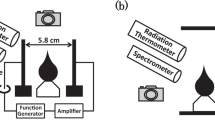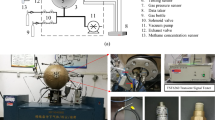Abstract
Hydrogen–air mixtures containing less than about 20 per cent hydrogen when burnt at an orifice undergo two highly contrasted modes of combustion which result in flame gases of very different types. In our experiments well-mixed mixtures of hydrogen and air contained in a tank were supplied to a burner in the form of a long narrow slit, the width of which was 1/16 in. The temperatures attained by very fine platinum – rhodium wires (0.0005 in. diameter) and by quartz-covered platinum wires (0.0005 in. overall diameter) were measured at some two hundred points in the flame gases. A contour map of the platinum wire temperatures in the lower portion of the flame gases resulting from the combustion of a 14 per cent mixture is shown in Fig. 1. These results are summarized in Fig. 2 and extended to a flame height twice that shown in Fig. 1. The temperatures measured by the quartz wire were almost exactly the same as those measured by the platinum wire, except in the early stages after combustion at the sides of the combustion zone (see dotted curves, Fig. 2).
This is a preview of subscription content, access via your institution
Access options
Subscribe to this journal
Receive 51 print issues and online access
$199.00 per year
only $3.90 per issue
Buy this article
- Purchase on Springer Link
- Instant access to full article PDF
Prices may be subject to local taxes which are calculated during checkout
Similar content being viewed by others
References
Proc. Inst. Mech. Eng., 151, 236 (1944).
Nature, 154, 115 (1944).
Author information
Authors and Affiliations
Rights and permissions
About this article
Cite this article
DAVID, W., MANN, J. Unusual Flame Gases. Nature 160, 229–230 (1947). https://doi.org/10.1038/160229b0
Issue Date:
DOI: https://doi.org/10.1038/160229b0
Comments
By submitting a comment you agree to abide by our Terms and Community Guidelines. If you find something abusive or that does not comply with our terms or guidelines please flag it as inappropriate.



